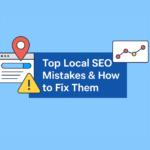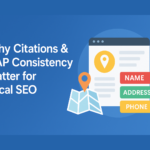- July 10, 2025
- Categories: SEO
- Tags:
Local SEO Strategy for Single & Multi-Location Businesses
Whether you’re a neighborhood coffee shop or a nationwide service provider, local search marketing remains one of the most profitable digital strategies in 2025. Over 46% of all Google searches have local intent, meaning people are actively looking for businesses near them.
A strong local SEO strategy ensures that your business shows up where it matters most on Google Maps, in the local pack, and across “near me” search queries. This guide covers both single-location and multi-location local SEO strategies to help you capture high-intent, location-specific customers.
What is Local Search Marketing?
Local search marketing is the process of optimizing your online presence so your business appears in local search results. It focuses on:
- Google Business Profile (GBP) optimization
- Local keywords
- Location-specific landing pages
- Reviews and citations
- Maps listings and mobile discoverability
It’s the key to showing up when people search things like:
- “best physiotherapist near me”
- “AC repair in Andheri”
- “organic grocery store in Bandra”
Local SEO Strategy for Single-Location Businesses
If you operate from a single storefront or service area, your focus should be laser-sharp. Here’s how:
1. Claim and Optimize Your Google Business Profile (GBP)
Your Google Business Profile (formerly Google My Business) is the foundation of your local SEO strategy. It directly influences whether your business appears in Google Maps results, the local 3-pack, and local searches. Start by claiming your profile and ensuring every detail is accurate.
Use your actual business name without keyword stuffing, and select the most accurate category (e.g., “Pediatric Dentist” instead of just “Dentist”) to help Google understand your offerings. Upload high-resolution photos of your store, staff, and products or services to build trust. Most importantly, ensure your Name, Address, and Phone Number (NAP) is consistent across your website and all listings.
Keep your profile fresh by posting regular updates, promotions, and events. A powerful feature many overlook is the Q&A section, use it to answer common questions or even add helpful FAQs proactively. This not only supports SEO but improves user experience.
2. Use Localized Keywords in Website Content
Incorporating geo-specific keywords into your website is crucial for being discovered in local searches. These are keywords that combine your service with your location, such as “emergency plumber in Dadar” or “wedding photographers in Thane.”
Naturally weave these phrases into key areas of your website including your homepage, service pages, meta titles, descriptions, and H1/H2 tags. Doing this helps search engines match your site with local intent queries.
Use tools like Google Keyword Planner, Ubersuggest, or Ahrefs to find the most relevant local keyword variations. Just be sure to maintain readability, your goal is to serve users first, then search engines.
3. Earn Local Citations & Directory Listings
Citations are online mentions of your business that include your Name, Address, and Phone number (NAP). These act like digital references and help Google validate your business’s legitimacy. Start by listing your business on popular Indian directories such as Justdial, Sulekha, IndiaMart, and Facebook Business.
Don’t overlook niche directories either. For example, Practo is great for medical professionals, 99acres works well for real estate agencies, and TripAdvisor suits restaurants and travel-related businesses.
The key to success here is NAP consistency. Ensure that your business name, address, and phone number are identical across all listings, down to the formatting. Any discrepancies can confuse search engines and negatively affect your rankings.
4. Get Reviews and Engage Actively
Online reviews, especially on Google, are one of the strongest ranking signals for local SEO. They not only influence your map pack position but also improve your click-through rate by showcasing your trustworthiness to potential customers.
Encourage happy clients to leave reviews regularly. After a service is completed or a purchase is made, send a polite follow-up asking for feedback. Make it easy by including a direct review link. Always respond to reviews, whether positive or negative, in a professional and timely manner.
Addressing negative feedback thoughtfully shows prospective customers that you care about quality and customer satisfaction, which builds trust and loyalty.
5. Create Location-Specific Landing Pages (If Needed)
If your business operates in multiple zones or suburbs, even if you have just one physical office, it’s a smart strategy to build dedicated location landing pages for each service area. These pages help you rank for local terms and serve content tailored to that specific audience.
Each location-specific page should include:
- Local testimonials or reviews
- Area-targeted keywords relevant to that region
- An embedded Google Map showing your service coverage
- A breakdown of services offered in that location
For example, if you’re a home cleaning service covering both Navi Mumbai and Powai, create two unique pages: one targeting “Home Cleaning Services in Navi Mumbai” and the other “Professional Cleaners in Powai.” This increases your chances of appearing in local search results for each area.
Local SEO Strategy for Multiple Locations
If you’re managing multiple physical locations, local SEO becomes more complex, but also more rewarding. Here’s how to scale it:
1. Create a Separate Landing Page for Each Location
When you operate in multiple cities or regions, it’s crucial to create dedicated landing pages for each location you serve. These pages should be unique in both content and structure, tailored specifically to the audience of that location.
Each landing page must clearly display the store name, address, contact number, and email. Use location-based keywords naturally in the content, such as “SEO services in Hyderabad” or “Digital Marketing Agency in Thane.” Enhance the page with location-specific images, customer testimonials from that area, and a custom Google Map embed pointing to the physical store.
This approach not only improves local discoverability but also builds user trust. Make your URLs clean and keyword-rich e.g., /locations/hyderabad-seo-services or /thane-digital-agency to help both users and search engines understand the page’s purpose.
2. Set Up Individual GBP Listings for Each Location
Each physical branch or service area of your business must have its own Google Business Profile (GBP). These listings increase the chances of appearing in local search results and map packs for each target location.
Ensure that every GBP listing uses a unique local phone number and links directly to its respective location-specific landing page and not the homepage. This strengthens Google’s association between the listing and that exact region. Don’t forget to update each profile with local offers, events, posts, and photos on a regular basis to stay relevant and engaging to your local audience.
This helps Google understand that each branch operates independently and should be ranked accordingly in search results for its region.
3. Use Local Business Schema Markup
To further reinforce your local authority, use LocalBusiness schema markup on every location page. Schema is a structured data format that helps search engines understand the context of your content, which can lead to rich results such as star ratings, contact info, and maps being displayed in search listings.
Your schema should include:
- Business name
- Physical address
- Opening hours
- Phone number
- Latitude and longitude coordinates
Implementing schema correctly allows Google to confidently associate your business with a specific location, improving visibility and increasing the likelihood of being featured prominently in local search results.
4. Central Review Management System
Managing customer feedback across multiple locations can get overwhelming. That’s why it’s important to use a centralized review management system like Birdeye or Reputation.com. These platforms allow you to collect, monitor, and respond to reviews from various locations within a single dashboard.
Consistently responding to reviews across all branches not only helps build local trust but also plays a vital role in local pack rankings. For added value, embed positive local reviews directly on your corresponding landing pages to boost social proof and conversion rates.
When users see positive testimonials from people in their own neighborhood, they’re much more likely to trust your brand and take action.
5. Build Local Backlinks
Backlinks from local, high-authority sources are essential to strengthening your business’s reputation within a specific area. Unlike generic backlinks, hyperlocal links tell Google that your brand is relevant and credible in a particular region.
You can earn these by:
- Collaborating with local bloggers or influencers
- Getting featured in local newspapers or digital magazines
- Sponsoring neighborhood events or charity causes
- Listing your business in the local Chamber of Commerce or B2B associations
Such links improve your domain authority, boost your rankings for localized searches, and also help generate referral traffic from your immediate community.
Local SEO is the Growth Engine for Regional Businesses
Whether you’re a solo entrepreneur or managing 100 stores nationwide, local SEO can be the single most effective way to grow your business with high-converting traffic.
The trick? Stay consistent, optimize smartly, and evolve your strategy as local search trends change.
Need Help Scaling Your Local SEO Strategy?
At VP Advertising Agency, we specialize in building location-specific digital marketing strategies that help brands dominate their neighborhoods and beyond.




